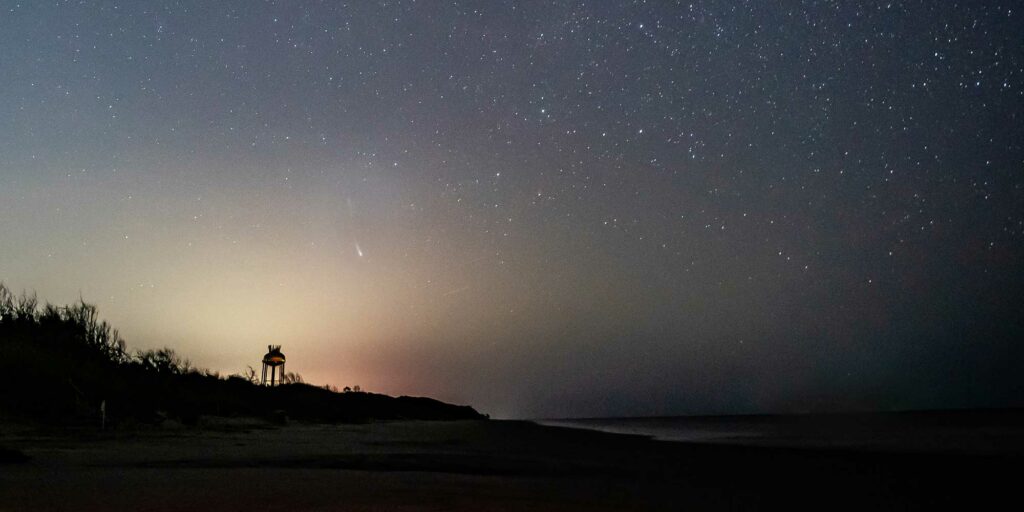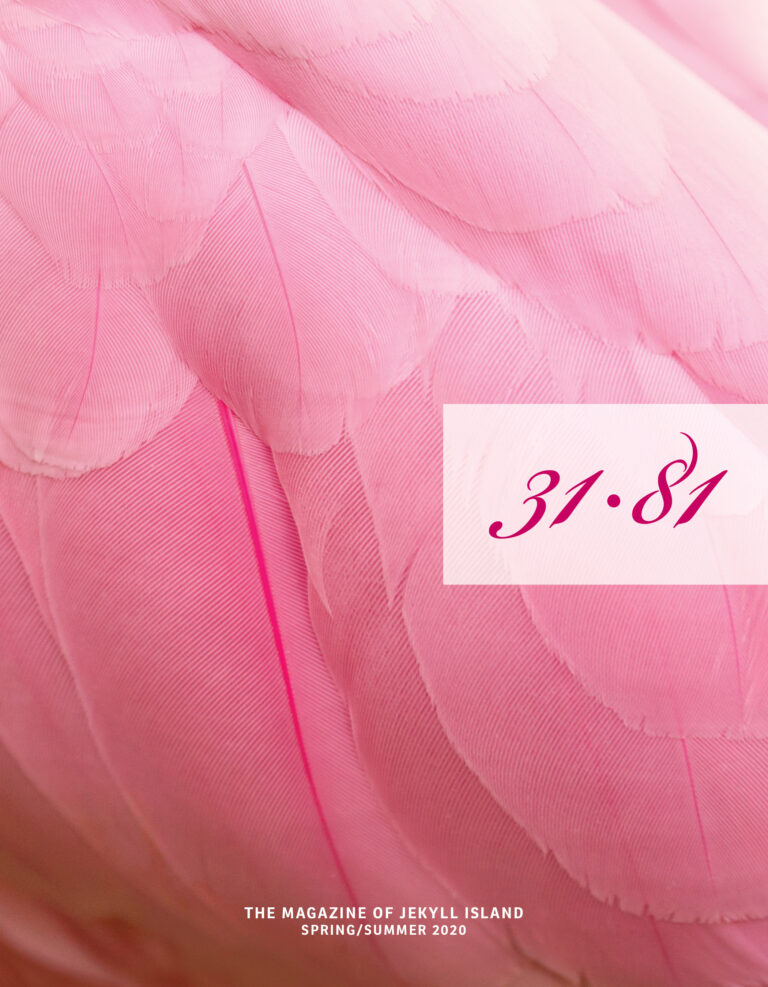As I learned firsthand, gazing at Jekyll’s night sky is both more complicated and exactly as simple as it sounds
By Elizabeth Florio
Illustrations by Kelsey Oseid
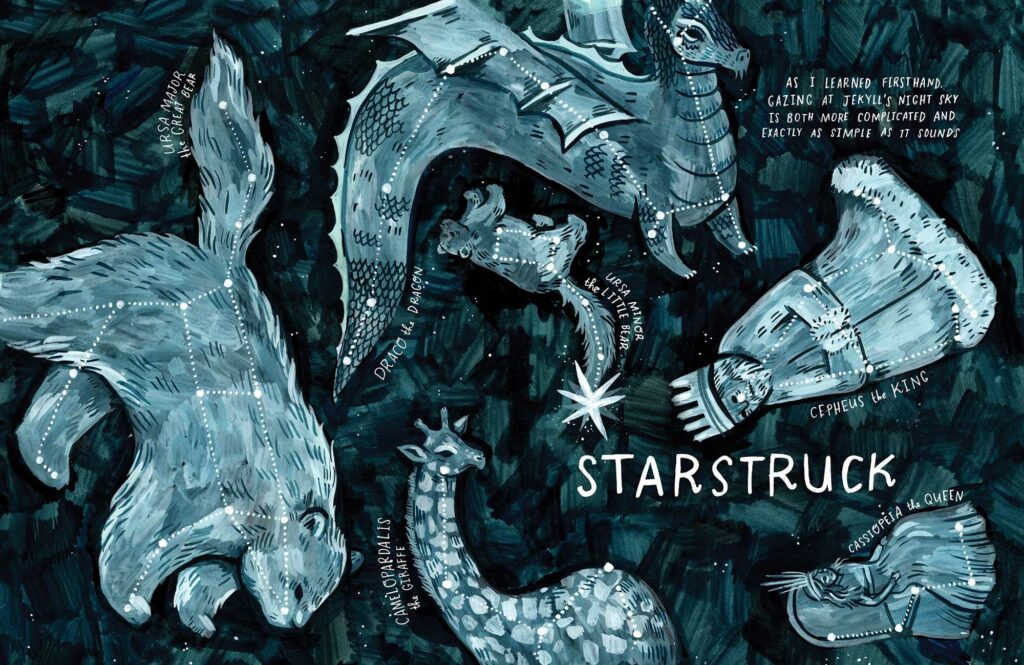
My first attempt at serious stargazing ended in embarrassment. I’d traveled to Jekyll Island with my mom and young daughter, three city girls armed with binoculars and a Sky Guide app. Conditions were optimal, the February air clear and bracing, the moon a day shy of being new.
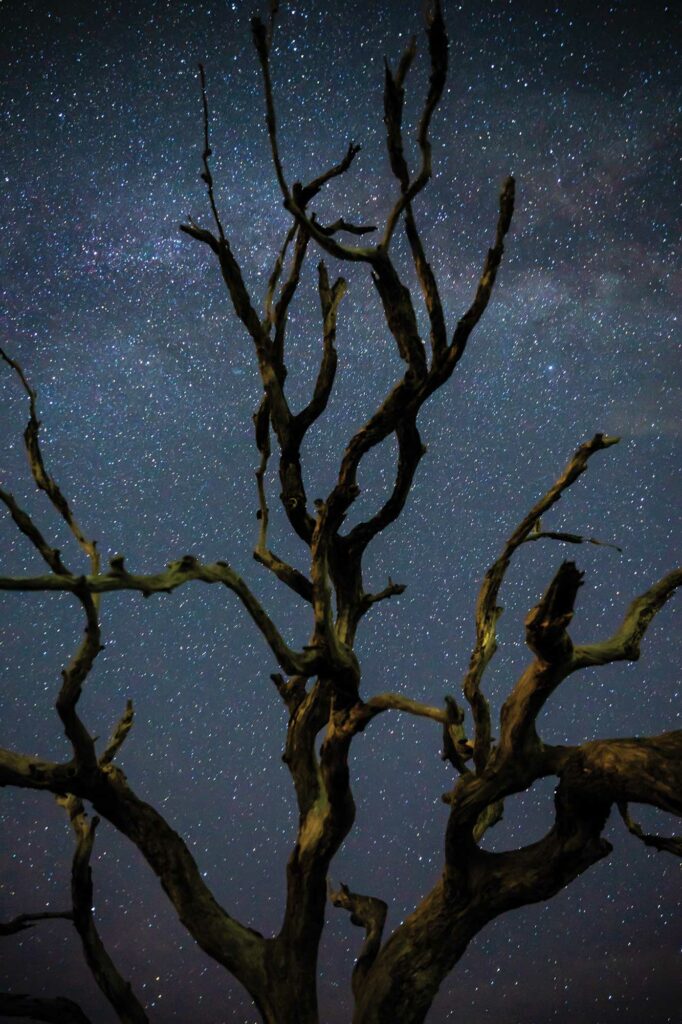
Stargazing Rule No. 1: For the sharpest view, pick a night with little to no moonlight.
I wondered about location, too. If you want to catch a sunrise, Driftwood Beach is your spot. But the lights of nearby St. Simons may interfere with constellation-spotting, I thought. Jekyll’s remote southern beaches seemed better suited to the task. So we headed south.
By day, Glory Beach is a broad, inviting stretch of sand pockmarked with seashells, a favorite spot for birders. It’s named for the 1989 film Glory, which was filmed here. To access the beach, a 200-foot-long boardwalk slices through a picturesque tangle of live oak, red cedar, and saw palmetto.
But by night, as we drove a lonely stretch of road to the Jekyll Island Soccer Complex, where Glory Beach and its boardwalk are located, the darkness deepened, broken only by my headlights and the reflected eyes of deer in the woods. Pulling into the deserted parking lot, we caught another pair of green eyes; an opossum, who shuffled under the boardwalk in no particular hurry. I switched off the engine and the world was blotted out.
We had driven five hours from Atlanta. All that stood between us now and an epic view of the heavens was a 200-foot walk in blackness like this city girl has rarely experienced through a thicket probably teeming with wild critters. (Visceral fear trumps reason. I had an actual lump in my throat. Some moonlight, I thought, would be nice.)
“Scared off by deer and an opossum,” my mom said as we lay down on our backs in the parking lot of the soccer complex. “We really are city girls.”
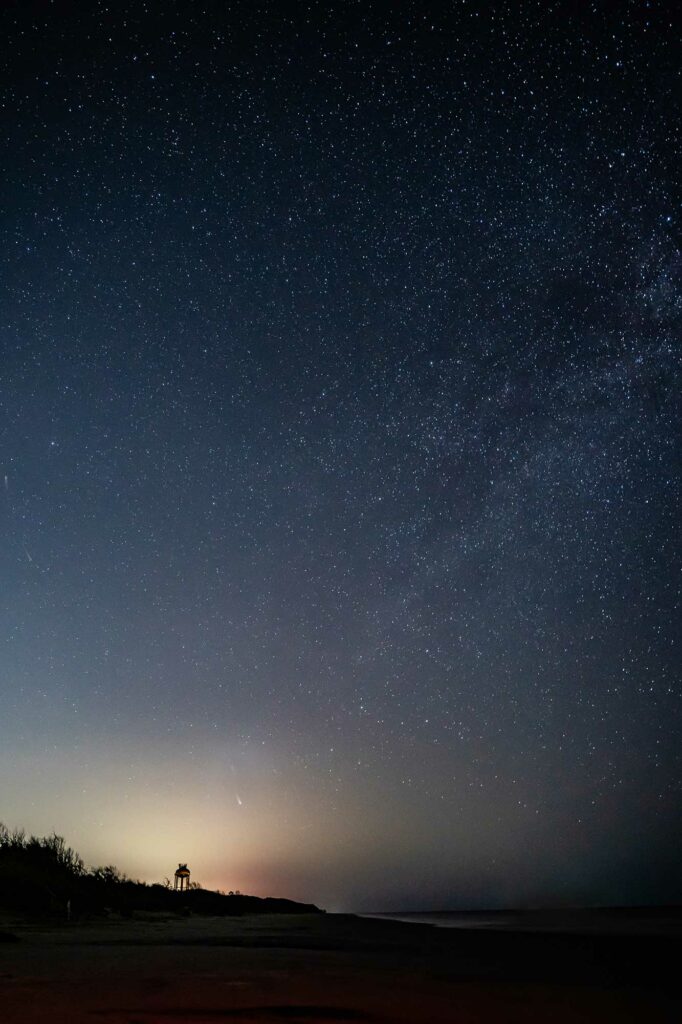
Stargazing Rule No. 2: Bring a blanket. All that craning will get to your neck.
The truth is, there’s not a bad place to sky-watch on Jekyll. That’s the opinion of Dawn Zenkert, coordinator of the UGA 4-H Tidelands Nature Center. “When I put my garbage out, I go, ‘Oh wow, look at the stars!'” she says. Zenkert moved to the island some 20 years ago, just in time to catch a meteor shower. She lay on the beach watching green streaks paint the night.
There are certainly more remote destinations in Georgia to stare at the night sky, and one certified dark sky park, Stephen C. Foster State Park in the Okefenokee Swamp. (If you’re game for a nighttime paddle over gator-infested waters, good for you.) But for an easy-access vacation locale, Jekyll gets pretty dark. The majority of the land is undeveloped. To protect sea turtle hatchlings that follow the horizon to the ocean, artificial beachfront lighting and even flashlights on the beach are forbidden.
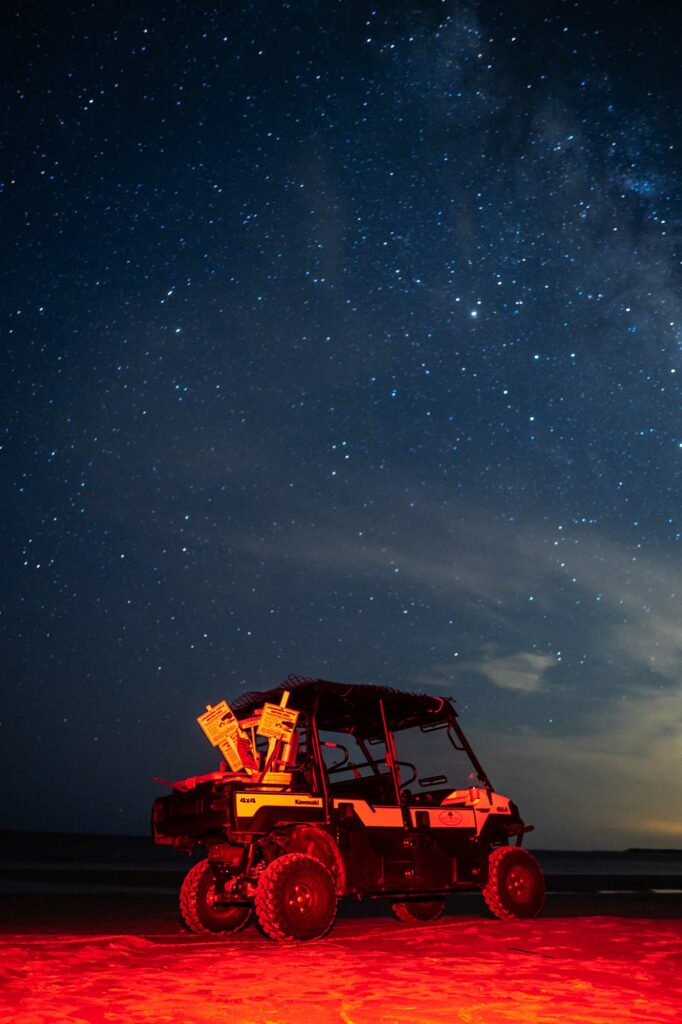
Stargazing Rule No. 3: Use a red LED flashlight. The longer wavelength preserves your night vision and, conveniently, doesn’t bother sea turtles.
About four times a summer, the Tidelands Nature Center hosts astronomy nights on a deck overlooking a saltwater pond. Attendees are shown a Power-Point tour of the sky before glimpsing the real deal through telescopes. They learn about things like circumpolar constellations, which never set below the horizon. In the Northern Hemisphere, these include Ursa Major (the Great Bear containing the Big Dipper), Ursa Minor (home to the North Star), Draco the dragon, Cepheus the king, and vain queen Cassiopeia, whose famous W shape traces a woman’s body as she reclines in a chair combing her hair.
The most important thing to know about stars is that they’re always there; we just can’t always see them. As the earth journeys around the sun, different stars shift into our nighttime view. The same holds true for planets, but as moving targets with varying orbital speeds, planets have less-fixed schedules. Venus, the brightest celestial object after the sun and moon, will retreat in May this year, ceding her majesty to Jupiter and Saturn. (Tip: If the light doesn’t twinkle, you’re looking at a planet, not a star.)
Dillon Marcy, coordinator of the Georgia Southern University Planetarium, grew up studying the constellations in Brunswick and St. Simons. He has two favorite landmarks in the summer sky: “Scorpio makes an easyto-find J hook, and the main part of Sagittarius looks like a teapot. In between them you can point to the center of our Milky Way, where a supermassive black hole is located.”
In enhanced photographs, the Milky Way appears as a volcanic rend in the sky, glowing orange and blue. Standing on a Jekyll beach on a moonless night, you might be able to distinguish a dim white arc. In most places you won’t see anything at all. Though it’s now fading from our light-polluted view, this galactic streak has long transfixed humans. The Mississippians, an ancient Native American civilization that flourished in the Southeastern United States, saw it as a “path of souls,” a springboard to our final destination.
In 1886, Northern business tycoons put Jekyll on the map by founding an exclusive resort community. The Jekyll Island Club drew Rockefellers, Vanderbilts, and one Robert C. Pruyn, who in 1893 financed the Pruyn equatorial telescope at the Dudley Observatory in Albany, New York. It would serve science for more than six decades. In 1911, club member Andrew Carnegie funded the completion of the Hooker Telescope at Mount Wilson Observatory in Los Angeles, the most powerful instrument of its time.
To be sure, a complex instrument like that can help unlock many secrets of the sky. But a portable telescope or a good pair of binoculars will reveal details like the moons of Jupiter or the elliptical shape of Andromeda, our nearest galaxy. And for novices, the naked eye and a clear forecast will do just fine. Take it from Marcy, who has an undergraduate degree in physics and astronomy and knows a nebula from a star cluster. For him, the allure of stargazing is basic: “We’re barely a grain of sand compared to the earth, the earth is barely a grain of sand to the sun, and if you look out on a dark night, you see thousands of other stars. That puts things into perspective.”
Though there isn’t a bad place to stargaze on Jekyll, when pondering your insignificance, an oceanside seat can’t be beat. On my second attempt, I learned that a short walk along the beach near my hotel afforded ample darkness. The water was a roaring shadow. The sky was littered with stars, the showiest orbs backstopped by a crowded mosaic of fainter specks.
Holding up my Sky Guide app, I scanned the names of what I saw. Stalwart Sirius, the dog star, the brightest star in the night sky (and actually two stars). The red giant Betelgeuse, recently dimmed by a cloud of circumstellar dust, triggering false hopes of a supernova. The Pleiades, a tight, adorable cluster that the Japanese call Subaru. Eventually I set down my phone and basked in the beauty and hugeness of it all.
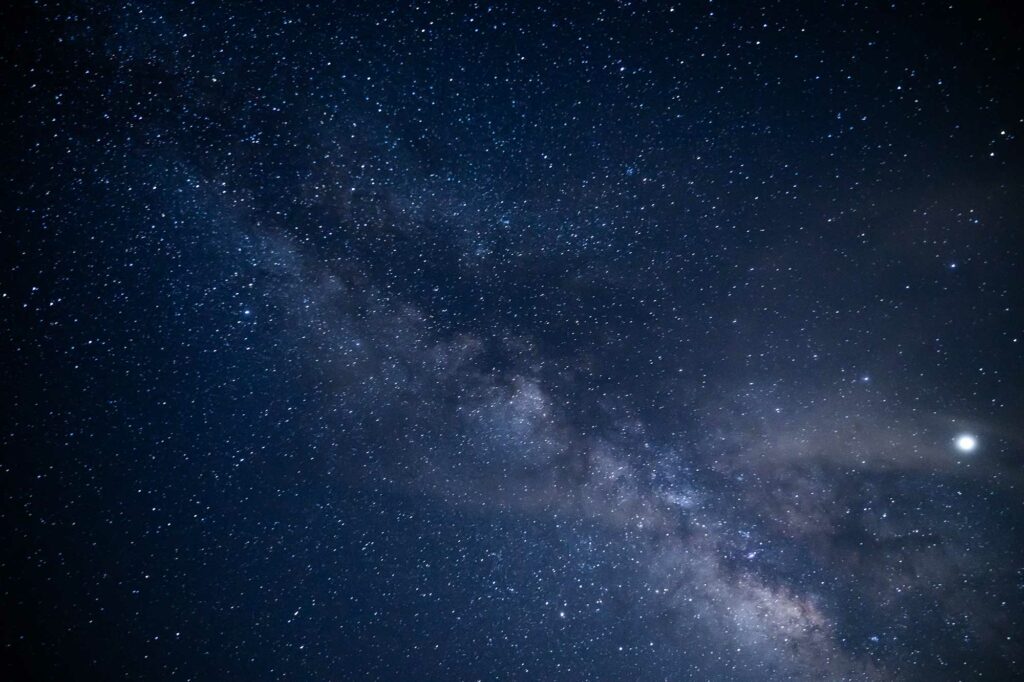
Stargazing Rule No. 4: No matter what equipment you bring, leave it alone for a while.
When astronauts enter space and look back at our fragile blue marble, a cognitive shift called the overview effect occurs. Political divisions disappear.
Borders suddenly seem petty. A wider view of home is born.
Most of us will never experience that perspective. Lying beneath this glittering dome is surely the next best thing.
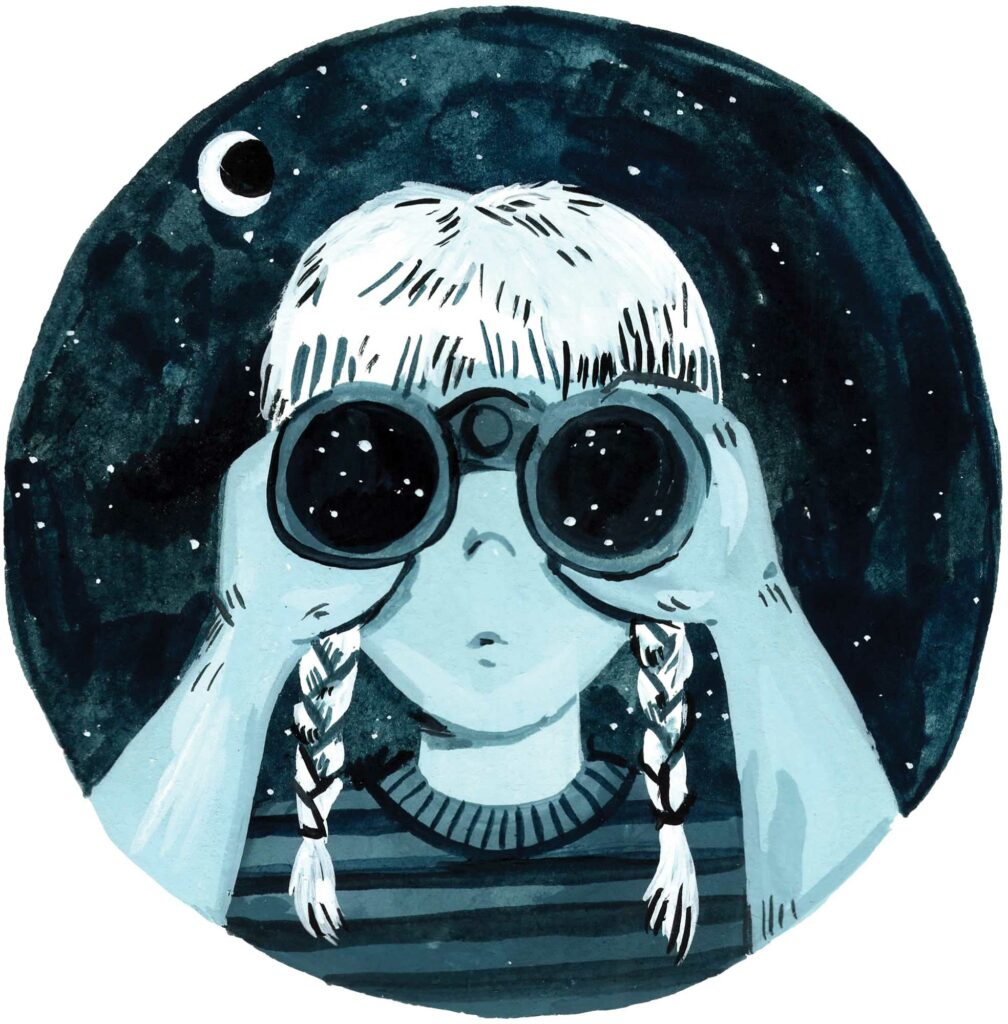
What To Bring
- A red LED flashlight is friendly to both sea turtles and astronomers. Ordinary white light flashlights are not permitted on Jekyll beaches from May to October.
- A stargazing app lets you point your smartphone at the sky and identify objects. Options include Sky Guide, SkyView, and Night Sky. Be sure to use your dimmest phone setting.
- A blanket or towel will save your neck.
- Binoculars (optional) are easy to bring along and, as a bonus, can be used for bird-watching during the day.
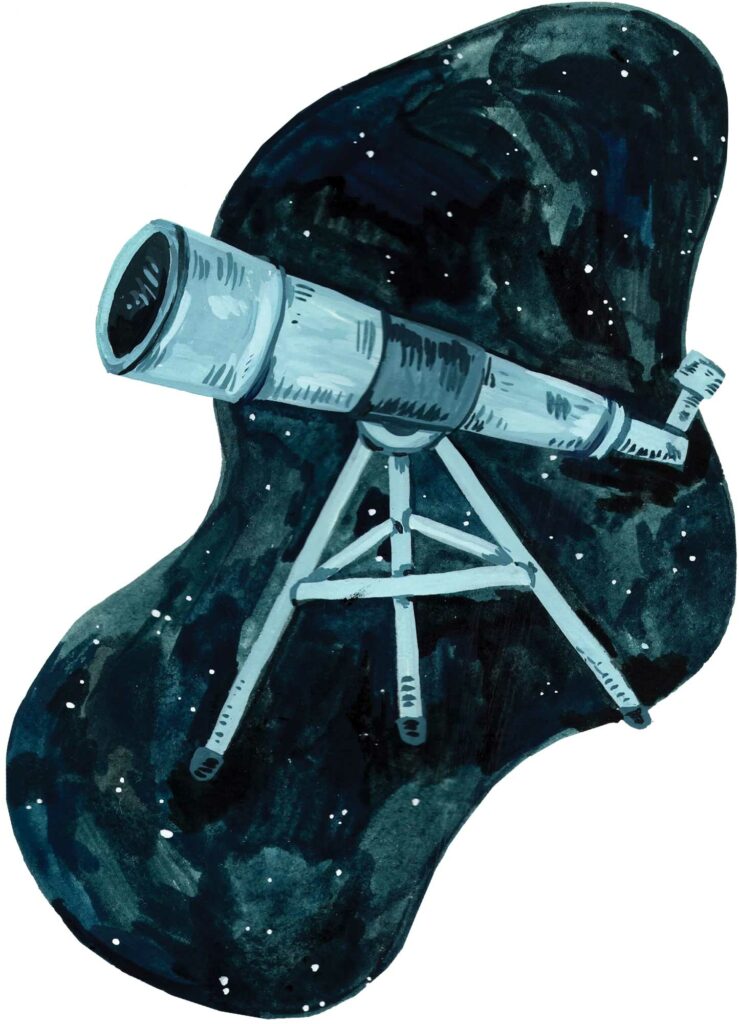
When To Gaze
- MID -JULY: Jupiter and Saturn will be in opposition, making our two biggest planets extra bright.
- AUGUST 11 -12: During the Perseid meteor shower, you can see as many as 100 meteors per hour.
- DECEMBER 13 -14: The Gemini meteor shower will correspond with a new moon, making for a spectacular light show.
- ANY MONTH: Check out spotthestation.nasa.gov to see when the International Space Station will pass high enough over your destination to be in view. You have only a few seconds to catch the exciting sight.
